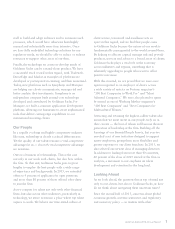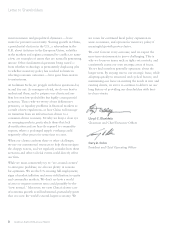Goldman Sachs 2015 Annual Report Download - page 19
Download and view the complete annual report
Please find page 19 of the 2015 Goldman Sachs annual report below. You can navigate through the pages in the report by either clicking on the pages listed below, or by using the keyword search tool below to find specific information within the annual report.THE GOLDMAN SACHS GROUP, INC. AND SUBSIDIARIES
There has been substantial consolidation and convergence
among companies in the financial services industry.
Moreover, we have faced, and expect to continue to face,
pressure to retain market share by committing capital to
businesses or transactions on terms that offer returns that
may not be commensurate with their risks. In particular,
corporate clients seek such commitments (such as
agreements to participate in their loan facilities) from
financial services firms in connection with investment
banking and other assignments.
Consolidation and convergence have significantly increased
the capital base and geographic reach of some of our
competitors, and have also hastened the globalization of the
securities and other financial services markets. As a result,
we have had to commit capital to support our international
operations and to execute large global transactions. To take
advantage of some of our most significant opportunities,
we will have to compete successfully with financial
institutions that are larger and have more capital and that
may have a stronger local presence and longer operating
history outside the United States. We also compete with
smaller institutions that offer more targeted services, such
as independent advisory firms. Some clients may perceive
these firms to be less susceptible to potential conflicts of
interest than we are, and, as described below, our ability to
effectively compete with them could be affected by
regulations and limitations on activities that apply to us but
may not apply to them.
A number of our businesses are subject to intense price
competition. Efforts by our competitors to gain market
share have resulted in pricing pressure in our investment
banking and client execution businesses and could result in
pricing pressure in other of our businesses. For example, the
increasing volume of trades executed electronically,
through the internet and through alternative trading
systems, has increased the pressure on trading commissions,
in that commissions for electronic trading are generally
lower than for non-electronic trading. It appears that this
trend toward low-commission trading will continue. In
addition, we believe that we will continue to experience
competitive pressures in these and other areas in the future
as some of our competitors seek to obtain market share by
further reducing prices, and as we enter into or expand our
presence in markets that may rely more heavily on
electronic trading and execution, such as consumer-
oriented deposit-taking activities.
The provisions of the U.S. Dodd-Frank Wall Street Reform
and Consumer Protection Act (Dodd-Frank Act), the
requirements promulgated by the Basel Committee on
Banking Supervision (Basel Committee) and other financial
regulation could affect our competitive position to the
extent that limitations on activities, increased fees and
compliance costs or other regulatory requirements do not
apply, or do not apply equally, to all of our competitors or
are not implemented uniformly across different
jurisdictions. For example, the provisions of the Dodd-
Frank Act that prohibit proprietary trading and restrict
investments in certain hedge and private equity funds
differentiate between U.S.-based and non-U.S.-based
banking organizations and give non-U.S.-based banking
organizations greater flexibility to trade outside of the
United States and to form and invest in funds outside the
United States. Likewise, the obligations with respect to
derivative transactions under Title VII of the Dodd-Frank
Act depend, in part, on the location of the counterparties to
the transaction. The impact of the Dodd-Frank Act and
other regulatory developments on our competitive position
will depend to a large extent on the manner in which the
required rulemaking and regulatory guidance evolve, the
extent of international convergence, and the development
of market practice and structures under the new regulatory
regimes as described further under “Regulation” below.
We also face intense competition in attracting and retaining
qualified employees. Our ability to continue to compete
effectively will depend upon our ability to attract new
employees, retain and motivate our existing employees and
to continue to compensate employees competitively amid
intense public and regulatory scrutiny on the compensation
practices of large financial institutions. Our pay practices
and those of certain of our competitors are subject to
review by, and the standards of, the Federal Reserve Board
and other regulators inside and outside the United States,
including the Prudential Regulation Authority (PRA) and
the Financial Conduct Authority (FCA) in the United
Kingdom. We also compete for employees with institutions
whose pay practices are not subject to regulatory oversight.
See “Regulation — Compensation Practices” below and
“Risk Factors — Our businesses may be adversely affected
if we are unable to hire and retain qualified employees” in
Part I, Item 1A of the 2015 Form 10-K for more
information about the regulation of our compensation
practices.
Goldman Sachs 2015 Form 10-K 7
























